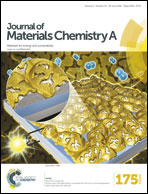Controlled pore evolution during phase inversion from the combinatorial non-solvent approach: application to battery separators†
Abstract
Phase inversion is a simple process to prepare porous thin films for lithium ion battery (LIB) separators. However, controlling porous morphologies during phase inversions for efficient lithium ionic transportation is a critical issue for more optimized battery performances. Here, we report an LIB separator via phase inversion by selecting non-solvents from the combinatorial approach. Interestingly, the formation of PVdF–HFP skeletons was governed by the controlled phase inversion with various mixtures of water, methanol, ethanol and 2-propanol. For a single non-solvent system, a water-based non-solvent (4 wt% water) was the best choice for the phase-inversion-based PVdF–HFP separators for LIBs. However, when a mixture of 2 wt% water and 3 wt% methanol was used as the non-solvent, the best rate capability and long-term stability were obtained, which led to better LIB performances than those of commercialized polyethylene separators.


 Please wait while we load your content...
Please wait while we load your content...